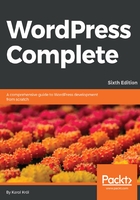
Using the Visual editor versus the Text editor
WordPress comes with a Visual editor, otherwise known as a WYSIWYG editor (pronounced wissy-wig, and stands for What You See Is What You Get). This is the default editor for typing and editing your posts. If you're comfortable with HTML, you may prefer to write and edit your posts using the Text editor--particularly useful if you want to add special content or styling. To switch from the rich text editor to the Text editor, click on the Text tab next to the Visual tab at the top of the content box:

You'll see your post in all its raw HTML glory, and you'll get a new set of buttons that let you quickly bold and italicize text, as well as add link code, image code, and so on. You can make changes, and swap back and forth between the tabs to see the result.
For example, going back to the post we were building just a minute ago, the one with the embedded podcast episode--when we switch between Visual and Text, we'll see that in the Visual editor mode, the link to the audio file has already been turned into a live audio player, while in the Text editor mode, we can still see the URL in its raw form. The next screenshot presents this side by side:

Even though the Text editor allows you to use any HTML element in existence, it's not a fully fledged HTML support. For instance, using <p> tags is not necessary for the Text editor, as they will be stripped by default. In order to create a new paragraph in the Text editor, all you need to do is press the Enter key twice. That being said, at the same time, the Text editor is currently the only way to use HTML tables in WordPress (within posts and pages).
You can easily place your table content inside <table>, <tr>, and <td> tags and WordPress won't alter them in any way, effectively allowing you to create the exact table you want. Another thing the Text editor is most commonly used for is introducing custom HTML parameters in <img/> and <a> tags, and also custom CSS classes in other popular tags. Some content creators actually prefer working with the Text editor, rather than the Visual editor because it gives them much more control and more certainty regarding the way their content is going to be presented on the frontend.